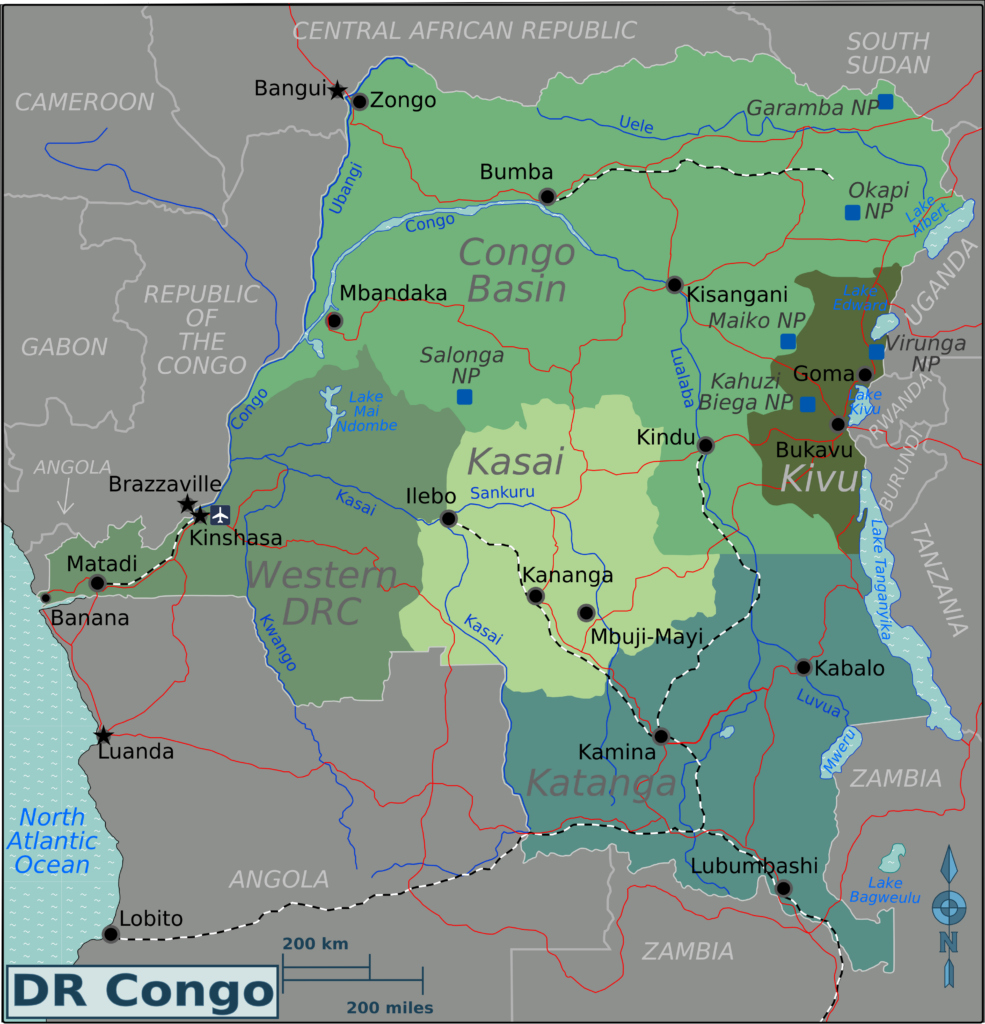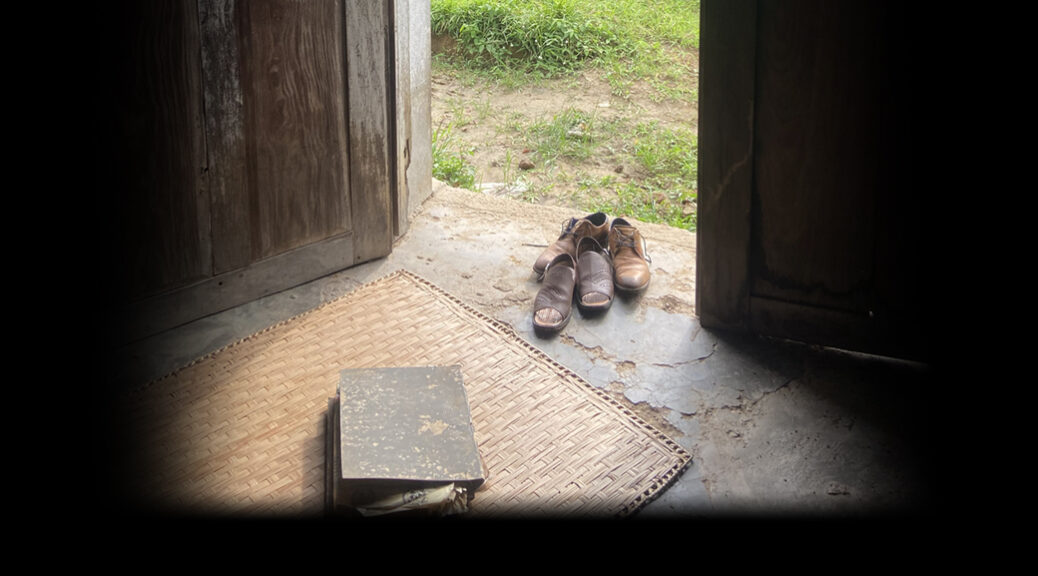Le projet / The project (English) / Mradi (Kiswahili) / (عربية) مَشْرُوع
Kalamu na wino. L’héritage de l’écriture arabe au Congo
Bienvenue sur Kalamu na wino. « Calame et encre », en swahili. L’objectif de ce blog multilingue est de faire connaitre au grand public, au Congo et ailleurs, un héritage fascinant encore largement méconnu : les documents en arabe et en kiswahili ajami (c’est-à-dire noté en caractères arabes) rédigés au Congo depuis les dernières décennies du 19e siècle — les plus anciens exemples conservés remontent aux années 1880 — jusqu’à la période contemporaine. Ces documents — de la correspondance, des traités, des contrats, mais aussi des livres et même des objets décorés — sont précieux à plusieurs titres. D’abord, ils démontrent que l’usage de l’écriture précède l’arrivée des Européens dans certaines régions du Congo, en particulier dans sa partie orientale, remettant en question l’exclusivité de la tradition orale dans la région. Ensuite, leur contenu nous pousse à revoir notre vision de l’Histoire précoloniale et coloniale du Congo : si la plupart de ces documents les plus anciens ont été rédigés par des commerçants et des lettrés venus de la Côte swahilie et du Soudan, parfois de plus loin encore, certains ont été dictés, voire écrits par des chefs locaux. En outre, ils contiennent aussi de précieuses informations à propos de certains événements historiques, du commerce, de l’organisation sociale, etc.
Par ailleurs, il ne s’agit pas seulement d’un héritage du passé : dans certaines communautés musulmanes, à Kisangani, dans le Maniema, dans le Kivu mais aussi à Kinshasa, l’écriture arabe continue d’être utilisée, et certains des ouvrages lus aujourd’hui à certaines occasions — des fêtes religieuses notamment — circulaient déjà dans le pays à la fin du 19e siècle, dévoilant la continuité de cet héritage sur bientôt un siècle et demi.
C’est cet héritage que nous voulons vous faire connaitre progressivement, en présentant régulièrement un document, un ouvrage, un personnage, un objet ou un événement en relation avec l’écriture arabe, éclairant l’Histoire culturelle du Congo d’un jour nouveau.
⁂
Kalamu na wino est financé par le programme WelCHANGE 2023 du Fonds de la recherche scientifique (FRS-FNRS) et la Faculté de Lettres, Traduction et Communication de l’Université libre de Bruxelles.


Kalamu na wino. The Legacy of Arabic Script in Congo
Welcome to Kalamu na wino. “Pen and ink”, in Swahili. The objective of this multilingual blog is to make known to a large audience, in Congo and elsewhere, the richness of a heritage that is still largely unknown: the documents written in Arabic and Ajami Swahili (Swahili in Arabic characters) which have been produced in Congo since the last decades of the 19th century — the oldest preserved examples date back to the 1880s — until the contemporary period. These documents — correspondence, treaties, contracts, but also books and decorated artifacts — are valuable for several reasons. First, they demonstrate that the use of writing precedes the arrival of Europeans in certain regions of the Congo, particularly in its Eastern part, questioning the exclusivity of the oral tradition in the region. Then, their content pushes us to review our vision of the precolonial and colonial history of the Congo: if most of the earliest documents were written by traders and scholars from the Swahili Coast and Sudan, sometimes from even further countries, some were dictated or even written by local leaders. In addition, they also contain valuable information about certain historical events, trade, social organization, etc.
Furthermore, it is not only a legacy of the past: in certain Muslim communities, in Kisangani, in Maniema, in Kivu and even in Kinshasa, Arabic writing continues to be used, and certain works that are read today on certain occasions — religious festivals, for instance — were already circulating in the country at the end of the 19th century, revealing the continuity of this heritage over almost a century and a half.
It is this heritage that we want to gradually make known, by regularly presenting a document, a work, but also a character, an object or an event which sheds new light on the cultural history of the Congo, in relation with the Arabic script.
⁂
This project is funded by the WelCHANGE 2023 program of the Belgian Fund for Scientific Research (FRS-FNRS) and the Faculty of Letters, Translation and Communication of the Université libre de Bruxelles (ULB)


Kalamu na wino. Urithi wa Hati za Kiarabu nchini Kongo
Karibu katika “Kalamu na wino”. Lengo la blogu hii ya lugha mseto ni kuifahamisha hadhira kubwa ya Kongo, na kwingineko, kuhusu utajiri wa urithi ambao bado haujulikani sana: nyaraka zilizoandikwa kwa Kiarabu na “Kiswahili Ajami” (Kiswahili kilichoandikwa kwa hati ya Kiarabu) ambazo zimezalishwa Kongo tangu miongo ya mwisho ya karne ya 19 — mifano ya zamani iliyohifadhiwa inaturudisha nyuma hadi miaka ya 1880 — hadi kipindi cha sasa. Nyaraka hizi — barua, mikataba, maafikiano, vitabu, na kazi za mikono zilizonakshiwa — ni vya thamani kwa sababu kadhaa. Mosi, vinaonesha kwamba matumizi ya maandishi yalianza kabla ya majilio ya wa Wazungu katika baadhi ya maeneo ya Kongo, hasa Mashariki ya Kongo, vikisaili hali ya kuwapo kwa mila ya masimulizi pekee katika eneo hilo. Kisha, yaliyomo katika maandishi hayo yanatusukuma kupitia upya mitazamo yetu ya historia ya kabla ya ukoloni na wakati wa ukoloni wa Kongo: iwapo nyaraka nyingi za mwanzo ziliandikwa na wafanyabiashara na wanazuoni kutoka Pwani ya Waswahili na Sudani, wakati mwingine kutoka nchi za mbali zaidi, baadhi zilikuwa imla au hata ziliandikwa na viongozi wa eneo hilo. Zaidi ya hayo, pia zina taarifa muhimu kuhusu matukio fulani ya kihistoria, biashara, mfumo wa kijamii, n.k.
Fauka ya hayo, huu si urithi wa kale tu: katika jamii fulani za Waislamu, huko Kisangani, Maniema, Kivu na hata Kinshasa, maandishi ya Kiarabu yanaendelea kutumika, na baadhi ya kazi zinazosomwa leo katika shughuli fulani fulani — kwa mfano, sherehe za kidini, zilikuwa tayari zinapatikana nchini humo mwishoni mwa karne ya 19, jambo linalodhihirisha uendelevu wa urithi huu kwa takribani karne moja na nusu.
Urithi huu ndiyo tunahitaji kuufanya ujulikane taratibu, kwa kuwasilisha mara kwa mara hati, kazi, halikadhalika herufi, kitu au tukio linalotupatia mwanga mpya kuhusu historia ya utamaduni wa Kongo, kuhusiana na maandishi ya Kiarabu.
⁂
[Financements en swahili]


تراث الكتابة العربية في الكونغو
مرحبا بكم على موقع قلم وحبر. تهدف هذه المدونة ذات اللغات المتعددة إلى تعريف عامة الناس، في الكونغو وفي أماكن أخرى، بثراء تراث لا يزال مجهولا إلى حد كبير: الوثائق المكتوبة باللغة العربية والسواحيلية العجمية (السواحيلية المكتوبة بالحروف العربية) التي كُتبت في الكونغو منذ العقود الأخيرة من القرن التاسع عشر – تعود أقدم الأمثلة المحفوظة إلى ثمانينات القرن التاسع عشر – إلى الفترة المعاصرة. تُعد هذه الوثائق – المراسلات والمعاهدات والعقود، وكذلك الكتب والقطع الأثرية المزخرفة – قيّمة لعدة أسباب. أولاً، تُظهر هذه الوثائق أن استخدام الكتابة يسبق وصول الأوروبيين إلى مناطق معينة من الكونغو، خاصةً في الجزء الشرقي منها، مما يشكك في حصرية التقاليد الشفهية في المنطقة. ثانيًا، يدفعنا محتواها إلى مراجعة رؤيتنا لتاريخ الكونغو قبل الاستعمار وفي الحقبة الاستعمارية: فإذا كانت معظم هذه الوثائق القديمة قد كتبت من قبل تجار ومثقفين من الساحل السواحيلي والسودان، وأحيانًا من مناطق أبعد، إلاّ أن بعضها أُمليت أو كُتبت من طرف قادة محليون. بالإضافة إلى ذلك، فهي تحتوي أيضًا على معلومات قيمة عن بعض الأحداث التاريخية والتجارة والتنظيم الاجتماعي، إلخ
وعلاوة على ما سبق، فإن هذا ليس مجرد إرث من الماضي: ففي بعض المجتمعات المسلمة في كيسانغاني ومانيما وكيفو وكينشاسا أيضًا، لا يزال الخط العربي مستخدمًا وبعض الكتب التي تقرأ اليوم في مناسبات معينة – خصوصا في الأعياد الدينية – كانت متداولة بالفعل في البلد في نهاية القرن التاسع عشر، مما يكشف عن استمرارية هذا التراث على مدى قرن ونصف تقريبًا
هذا هو التراث الذي نريد أن نعّرفكم عليه تدريجيًا، من خلال تقديم وثيقة، كتاب، شخصية ما، تحفة أو حدث متعلق بالكتابة العربية مع تسليط ضوء جديد على التاريخ الثقافي للكونغو
⁂
يتم تمويل هذا المشروع من قبل صندوق البحوث العلمية (بلجيكا) وكلية الآداب والترجمة والاتصالات في جامعة بروكسل الحرة

Carte
Map / Ramani / خريطة

Bibliographie indicative
Selected bibliography / Vyanzo / بعض المصادر
Abel, A. 1954. Traduction de documents arabes concernant le Bahr-el-Ghazal (1893- 1894). — Bulletin des Séances Académie royale des Sciences coloniales, XXV (5): 1385-1409.
Abel, A. 1957. Un drapeau magique musulman provenant de la campagne contre Rumaliza. — Bulletin des Séances Académie royale des Sciences coloniales, III (3): 579-587.
Abel, A. 1959. Les Musulmans noirs du Maniema. — Bruxelles, Centre pour l’étude des problèmes du monde musulman contemporain.
Bontinck, F. 1974. L’autobiographie de Hamed ben Mohammed el-Murjebi TippoTip (ca. 1840-1905). — Bruxelles, Académie royale des Sciences d’Outre-Mer, mémoire Classe des Sciences morales et politiques, N. S., XLII (4).
Coopman, P. 1988. Proeve van vertaling en commentariering van acht ‘arabische’ documenten betreffende de 19de eeuwse centrale handelsroute in Oost- en –385– Midden-Afrika (1890-1894). — Gent, Rijksuniversiteit Gent (unpublished).
Detry, A. 1912. À Stanleyville. — Bruxelles, J. Lebègue; Liège, La Meuse.
Knappert, J. 1973. A Swahili islamic prayer from Zaire. — Orientalia Lovaniensia Periodica, 4: 197-201.
Luffin, X. 2020. Un autre regard sur l’Histoire congolaise. Les documents arabes et swahilis dans les archives belges (1880-1899). Bruxelles, Fontes Historiæ Africanæ.
Luffin, X. 2017. Arabic and Swahili documents from the pre-colonial Congo and the EIC (Congo Free State, 1885-1908): Who were the scribes? — In: Brigaglia, A. & Nobili, M. (Eds.), The Arts and Crafts of Literacy: Islamic Manuscript Cultures in Sub-Saharan Africa. Berlin, De Gruyter.
Luffin, X. 2013. Swahili Documents from Congo: Variation in Orthography – Arabic Script in Africa: Studies on the Usage of a Writing System, Leyde, Brill: 311-318.
Luffin, X. 2008. Les premières explorations arabes du Congo d’après une source omanaise: le Juhaynat al-aḫbâr fi tarîḫ Zinjibâr de Sa‘id bin ‘Ali al-Mughiri. — Annales Æquatoria, 29: 425-445.
Luffin, X. 2007a. About some Swahili documents from Congo (19th century). — Swahili Forum, 14: 17-26.
Luffin, X. 2007b. Cinq traités en caractères arabes du Marungu. — Annales Aequatoria, 28: 186-215. Luffin, X. 2007c.
Luffin, X. 2004a. L’usage de l’arabe et de l’arabo-swahili en Afrique centrale (Congo, Rwanda, Burundi). Périodes précoloniale et coloniale. — Folia Orientalia, 40: 1-22.
Luffin, X. 2004b. L’arabe parlé au Congo selon deux lexiques publiés par l’État Indépendant du Congo (1904-1905). — Annales Aequatoria, 25: 373-396.
Luffin, X. 2004c. The use of Arabic as a written language in Central Africa in the late 19th century: The case of some Azande documents. — Sudanic Africa, 15: 145-177.
Marechal, P. 1992. De ‘Arabische’ campagne in het Maniema-gebied (1892-1894): situering binnen het kolonisatieproces in de Onafhankelijke Kongostaat. — Tervuren, Koninklijk Museum voor Midden-Afrika, Annalen Historische Wetenschap.
Mumin, M. & Versteegh, K. (Eds.), The Arabic Script in Africa. Studies in the Use of a Writing System. Leiden-Boston, Brill.


